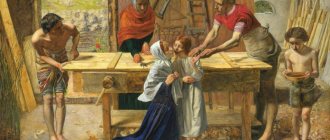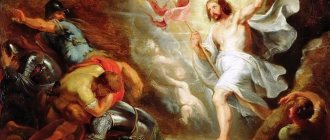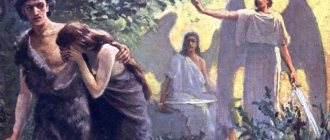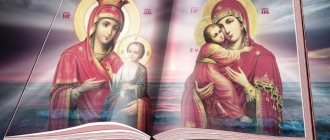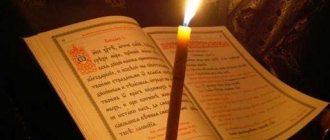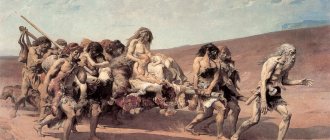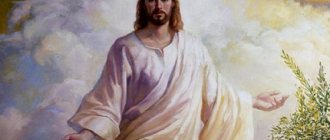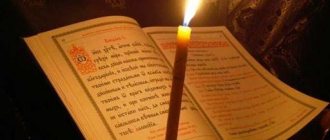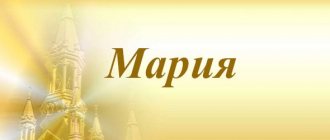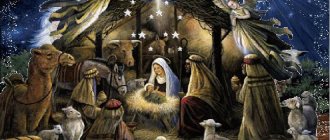"Save me, God!".
Thank you for visiting our website, before you start studying the information, please subscribe to our Orthodox community on Instagram, Lord, Save and Preserve † - https://www.instagram.com/spasi.gospodi/. The community has more than 60,000 subscribers. There are many of us like-minded people and we are growing quickly, we post prayers, sayings of saints, prayer requests, and timely post useful information about holidays and Orthodox events... Subscribe. Guardian Angel to you!
There are many holy images in Orthodoxy. But most often it is customary to pray to the Virgin Mary. It is Her image that is considered to be the feminine principle. This is the face of the mother of Christ, the giver of life. It includes the divine miracle of emerging life and ordinary earthly life. Her life was not easy. She had to endure quite a lot of sorrow and go through a thorny path.
Biography of the Virgin Mary, mother of Jesus
The parents of the Blessed Virgin Mary were deeply religious people. They always strictly adhered to God's commandments and lived righteously. The family lived in prosperity and understanding. There was only one sorrow in their life. There was no way they could have children. For a long time, the married couple offered prayers to the Almighty so that he would send them the long-awaited happiness - a child. Those around them laughed at them and at their grief.
Having been married for 50 years, the couple no longer believed that they would have children. One day, while walking in the garden, Anna had a vision of an angel who told her that she would soon experience maternal happiness, and her child would certainly become famous later. The woman came home to tell her husband about what she saw. It turned out that Joachim also received the same news. Not long after that meeting, Anna found out that she was pregnant. Then the couple decided that the child would be sent to a temple school to serve God. The baby was born on time. She was named Maria.
When the Blessed Virgin Mary was born, the neighbors again began to gossip and pour negativity on the couple, only now about the miracle that had occurred, that a child had appeared in the family. The happy couple did not pay attention to the talk of their neighbors and raised their long-awaited daughter in happiness and love. When the baby was three years old, she was sent to be raised in the Jerusalem temple. The first miracle was that Mary, at such a young age, independently climbed 15 steps to the gates of the temple. An adult could not always pass them, but a child did it with ease.
The best article for you, go to: Jesus Christ from birth to ascension
A few more years passed and my parents died. The baby continued to live and study in the temple. At the temple, girls were taught:
- Orthodox faith;
- taught to cook and clean;
- basic child care rules;
- cutting and sewing.
Most of all the girl liked to sew. Until the age of 11-13, the girl lived in an Orthodox school at the temple.
She was supposed to be an enviable bride. But the girl was not interested in such a life and she took a vow of celibacy. Since adult ladies were not allowed to live at the temple, she had to leave her place of study, but in those days she also could not live alone. The school teachers found a way out of the situation; they married her to Elder Joseph. In turn, the man was not very happy about his new wife, as he was afraid of the gossip of others, but he did not refuse and took Maria into his house as his wife.
Theotokos, Virgin Mary, who gave birth to Jesus Christ: Life
| Presentation of the Virgin Mary into the Temple. Icon gray XVI century |
P. Yu. Malkov
Article from volume V of the Orthodox Encyclopedia, Moscow. 2002 Information about the life of the Mother of God contained in the Holy Scriptures of the New Testament is not sufficiently detailed. There are only a few episodes related to the name and personality of the Mother of God (Matt 1. 16, 18–25; 2. 11, 13–15, 19–23; 12. 46–50; 13. 55; Mark 3. 31–35 ; Luke 1. 26–56; 2. 4–7, 16–52; 8. 19–21; John 2. 1–12; 19. 25–27; Acts 1. 14). From the biblical story we learn nothing about the circumstances of Her Nativity, nor about the Entry into the Temple, nor about the life of the Virgin Mary after Pentecost. Such details of the life of the Mother of God are conveyed to us by Church Tradition: ancient legends, church historical works, homiletical monuments, hymnographic liturgical heritage. The initial sources of extra-biblical information about the life of the Mother of God were the early Christian apocrypha: “The Story of Jacob about the Birth of Mary” (otherwise the “Proto-Gospel of Jacob”; 2nd half–late 2nd century, Egypt), “The Gospel of Childhood” (otherwise the “Gospel of from Thomas"; II century), "The Book of Joseph the Carpenter" (c. 400, Egypt), "St. John the Theologian's tale of the Dormition of the Holy Mother of God" (IV-V centuries). Not recognizing the apocrypha as a source of doctrine, the Church, at the same time, borrowed from them a whole series of subjects related to the earthly life of the Mother of God. At the same time, the apocryphal stories themselves in the new edited version were cleared of the Gnostic element and agreed with the canonical story about the Mother of God contained in the Four Gospels. The popularity of stories borrowed from the apocrypha related to the personality of the Mother of God was also facilitated by numerous translations of the ancient apocrypha into various languages: the “Gospel of Childhood,” for example, was translated into Syriac, Coptic, Armenian, and Georgian; there are also its Latin (known as the “Gospel of Pseudo-Matthew”), Ethiopic, Arabic and Slavic (“History of Thomas the Israelite”, “Infancy of Christ”) versions. The long, centuries-long work of purifying apocryphal materials related to the image of the Mother of God from the non-Orthodox ideas and themes unacceptable to the Church contained here led to the formation of a single and internally consistent Tradition about the earthly life of the Mother of God, to the establishment of a relationship between the circumstances of Her life and the liturgical annual cycle (apocryphal tales about The Mother of God was actively used by such famous hymn writers as St. Andrew of Crete, St. Cosmas of Maium and St. John of Damascus). Since ancient times, stories about the life of the Mother of God have found a lively response among Orthodox Christians and were their favorite reading. They were part of various hagiographic literary traditions of local Churches. The legends were also reflected in the sermons of the holy fathers (St. Ephraim the Syrian, St. John Chrysostom, St. John of Damascus, St. Gregory Palamas, etc.) on church holidays.
Tradition testifies that at the turn of two eras of world history, separated by the birth of Christ, middle-aged and childless spouses, the holy righteous Joachim and Anna, lived in the city of Nazareth. All their lives, dedicated to fulfilling God's will and serving their neighbors, they dreamed and fervently prayed that the Lord would give them a child. Joachim and Anna made a vow: if they do have a son or daughter, then his or her life will be devoted to serving God. Finally, after 50 years of their marriage, the prayer of the elderly righteous was heard: they named their daughter Mary (translated from Hebrew as “lady” or “hope”). The girl, who brought consolation and spiritual relief to the elderly and God-fearing spouses, was destined to become the Mother of the future Savior of the world, the Son of God. According to her father, She came from the tribe of Judah, from the family of David; on the mother's side - from the tribe of Aaron; among Her ancestors were the Old Testament patriarchs, high priests, rulers and kings of the Jews.
Church Tradition brings to us a number of significant circumstances of the event of the Nativity of the Virgin Mary. Joachim and Anna suffered greatly because of their infertility, in which Old Testament morality saw God's punishment. Joachim was even prevented from making sacrifices in the temple, believing that he was displeasing to God because he did not create offspring for the Israeli people. Joachim knew that many Old Testament righteous people, for example. Abraham, like him, did not have children until his very old age, but then God, through their faith and prayers, still sent them offspring. Joachim withdrew into the desert, set up a tent there, where he prayed and fasted for 40 days and nights. Anna, like her husband, bitterly mourned her childlessness. And she, like her husband, was humiliated by those around her for her infertility. But one day, when Anna was walking in the garden and praying to God that He would give her a child, as He had once given offspring to the elderly Sarah, an angel of the Lord appeared before Anna and promised her that she would soon give birth and that her offspring would be talked about all over the world ( Proto-Gospel 4). Anna made a vow to dedicate her child to God. At the same time, an angel appeared to Joachim, announcing that God had heeded his prayers. Joachim returned home to Anna, where the conception and Nativity of the Virgin Mary soon took place.
The elderly parents made thanksgiving sacrifices to God for the gift given to them. After the birth of her daughter, Anna made a vow that the baby would not walk on earth until the parents brought Mary into the temple of the Lord. “...They are from Him,” says St. Gregory Palamas, - they accepted the promise of Your birth and, doing well, You, promised to them, were in turn promised to Him...” (Greg. Pal. In Praesent. 8). When will The Mother of God reached the age of 3, Joachim and Anna, who had put off Her dedication to God until that moment, decided that the time had come to bring Mary to the temple. According to legend (Protoevangelium 7), Mary’s entry into the temple was accompanied by a solemn procession; along the road to the temple stood young virgins with lighted lamps. “...Let Joachim rejoice with Anna, for holy fruit has come from them, luminous Mary, divine light, and rejoice as they enter the temple...” (sedalen on polyeleos). Her parents placed Her on the first of the 15 high steps of the temple. And here, according to the legend passed on by the blessed one. Jerome of Stridon, a miracle happened: Mary, on her own, without anyone’s support, climbed the steep steps and entered the temple (Hieron. De nativit. S. Mariae). At that same moment, the high priest came out to meet Her: according to legend, Zechariah - Bud. father of John the Baptist (Forerunner). He, by a special revelation of God, led Mary into the Holy of Holies, where the high priest had the right to enter only once a year. After this, Joachim and Anna left Mary at the temple. Her whole life in the temple was a matter of special Providence of God. She was raised and studied together with other virgins, worked on yarn and sewed priestly vestments. I'm eating. An angel brought it to the Mother of God. “The Holy of Holies of existence, the Pure One, you loved to dwell in the holy temple, and with the angels, the Virgin, you abided in conversation, most gloriously receiving bread from heaven, Nourisher of Life” (troparion of the 4th song of the 2nd canon for the Introduction).
Tradition tells that the Mother of God lived at the temple for up to 12 years. The time had come when She had to leave the temple and get married. But She announced to the high priest and priests that she had taken a vow of virginity before God. Then, out of respect for her vow and to preserve Her virginity, so that the young virgin would not be left without protection and care (Her parents had died by that time), Mary was betrothed to the elderly carpenter Joseph, who came from the family of King David. According to legend, the Lord Himself pointed to him as a future. betrothed and protector of the Mother of God. The temple priests gathered 12 men from the line of David, placed their staffs on the altar and prayed that God would show him who was pleasing to Him. Then the high priest gave each one his staff. When he gave the staff to Joseph, a dove flew out of it and sat on Joseph’s head. Then the high priest said to the elder: “You have been chosen to receive and guard the Virgin of the Lord.” (Proto-Gospel. 9). The Mother of God settled in Joseph's house in Nazareth. Here She remained in labor, contemplation and prayer. At this time, the need arose to make a new curtain for the Jerusalem temple. The Virgin Mary performed part of the work on behalf of the high priest.
The moment of the Annunciation has arrived. This event is described in the New Testament by the Evangelist Luke (1. 26–38). God sent arch. Gabriel, so that he would announce to Her the imminent Nativity of the Lord from Her. According to legend, at the moment when the archangel appeared before Her, She read an excerpt from the Book of the Prophet Isaiah, “Behold, a virgin will receive with child...” (Is 7.14). The Mother of God began to pray that the Lord would reveal to Her the mysterious meaning of these words and would quickly fulfill His promise. Just at that moment She saw the arch. Gabriel, who announced to Her about the imminent birth of her Son. The baby will be the Son of the Most High, will be called Jesus, will inherit the throne of David, and His Kingdom will have no end. Mary is perplexed: how can all this be fulfilled if She remains a virgin? The angel answers: “The Holy Spirit will come upon You, and the power of the Most High will overshadow You; therefore the Holy One who is to be born will be called the Son of God” (Luke 1:35). Mary, in response to the words of the archangel, gives Her voluntary consent to the Incarnation: “Behold, the Servant of the Lord; Let it be done to me according to your word” (Luke 1:38). Arch. Gabriel departs from the Mother of God. The unmarried conception of the Lord Jesus Christ takes place.
After the event of the Annunciation, the Mother of God went to visit Her relative. Elizabeth, future mother of St. John the Baptist (Forerunner). The righteous Zechariah and Elizabeth lived in the Levitical city of Juta. According to legend, on the way to Iuta, the Mother of God visited Jerusalem and handed over ready-made needlework to the temple - part of the new veil. There, over the Mother of God, the high priest pronounced a sublime blessing, saying that the Lord would glorify Mary in all generations of the earth (Proto-Gospel. 12). The event of the meeting of the Mother of God and Elizabeth is described by the Evangelist Luke (Luke 1. 39–56). At the moment of the meeting of Mary and Elizabeth, the baby leaped in Elizabeth’s womb. She was filled with the Holy Spirit and uttered prophetic words about the Mother of the Lord, who visited her home. The Mother of God answered her with a solemn poetic hymn: “My soul magnifies the Lord...” (Luke 1.46-55), glorifying the mercy of God shown to Israel in fulfillment of ancient prophecies about the Messiah. She testifies that from now on all generations living on earth will please Her. The Mother of God was in the house of Zechariah and Elizabeth ca. 3 months, then returned to Nazareth.
Soon Joseph noticed that Mary was carrying a fetus in her womb and was embarrassed by this. He wanted to secretly release Her from his home, thereby freeing her from persecution under the harsh Old Testament law. However, an angel appeared to Joseph in a dream and testified that the Child born from the Mother of God was conceived by the influx of the Holy Spirit. She will give birth to a Son, who should be called Jesus, since He will save humanity from sins. Joseph was obedient to the will of God and accepted Mary, again, as before, protecting Her purity and virginity (Matthew 1. 18-25).
The New Testament story about the event of the Nativity of Christ is contained in two complementary Gospels - Matthew (1. 18–2. 23) and Luke (2. 1–20). Here it is told that during the reign of Emperor. Augustus in Rome (under whose rule Palestine was at that time) and King Herod in Judea, by decision of the emperor, a population census was organized. At the same time, for their participation in the census, Jews had to come to the cities where their family came from. Joseph and Mary, who by that time was already expecting the imminent birth of a Child, came to Bethlehem, since they came from the family of King David (Euseb. Hist. eccl. I 7. 17). Bethlehem was the city of David. Not finding free places in the hotel, they were forced (although it was the cold season) to settle in a cattle pen - according to Church Tradition, dating back to early Christ. apocrypha and in the testimonies of the ancient Church Fathers (Iust. Martyr. Dial. 78; Orig. Contra Cels. I 51), it was a cave. In this cave at night, the Infant Jesus Christ was born to the Blessed Virgin. Christmas took place without the usual physical suffering for women in labor. The Mother of God Herself swaddled the Lord after His Nativity and placed him in a manger, where they put feed for livestock. Here, in the cave, She witnessed the worship of the Lord by the shepherds and composed in Her heart the words of their story about the miraculous appearance in the field of angelic powers (Luke 2. 8-14, 19).
On the 8th day after Christmas, the rite of circumcision and naming was performed on the Infant of God (Luke 2.21), and after 40 days they brought Him to the Jerusalem temple. This event is remembered by the Church under the name of the Presentation of the Lord. His circumstances are described by the Evangelist Luke (2.22–38). The baby was brought to the temple in fulfillment of the ancient customs of the Old Testament law of Moses (Lev 12.1-8). In accordance with this law, women, after 40 days if a boy was born, and 80 days if a girl was born, had to come to the temple to make a cleansing sacrifice.
The Mother of God also visits the temple to make such a sacrifice. She brings 2 turtle doves and 2 pigeon chicks - a sacrifice that is legally permissible only for the poor. According to custom, after making a sacrifice for the firstborn son, the priest took the baby from the mother’s arms and, turning to the altar, raised the child high, as if handing him over to God. At the same time, he performed 2 prayers over him: one - for the law of the ransom (the firstborn sons of the Israelites were intended, as belonging to God (Isa. 13. 1-2), to serve in the tabernacle and temple - later these duties were assigned to the Levites (Numbers 8 14–19), but the law provided for the possibility of release from this service through a ransom), others - for the gift of the firstborn.
The Infant Christ was met at the entrance to the temple by the pious and righteous elder Simeon. The elder said thanks to God and his famous “Now you let go...”. He turned to the Mother of God, prophesying about Her fate: “... and a weapon will pierce your very soul...”. The words about the “weapon,” that is, about the sword with which the heart of the Mother of God will be pierced, are a prophecy about the suffering that She will experience when She witnesses the torment and death on the Cross of Her Divine Son.
According to the ancient Tradition of the East. Church, it was after the event of the Presentation (Ephraem Syri. In Deatess.; and not on the night of Christmas - Ioan. Chrysost. In Matt. 1. 1; cf.: Theoph. Bulg. In Matth. 1. 1) that the veneration of the Infant God took place for those who came with East of the Magi (Matthew 2. 1–12). Herod, deceived by them, sought the death of Christ, and the Holy Family soon - at the direction of the angel who appeared to Joseph - was forced to leave Palestine and flee to Egypt (Matthew 2:13-15). From there, Joseph and the Virgin and Child returned to their homeland only after they learned that Herod had died. Joseph learned about the death of the king from an angel who appeared to him in a dream (Matthew 2:19–21).
A number of pious traditions related to the stay of the Holy Family in Egypt have been preserved. So, according to one legend, on the way to Egypt they came across robbers, two of whom were on patrol, the rest were sleeping. One robber, who vaguely sensed the Divine greatness of the Child, prevented his comrades from harming the Holy Family. Then the Mother of God said to him: “The Lord God will support you with His right hand and grant you remission of sins” (Arabic Gospel of the Savior’s Childhood. 23). According to legend, it was this merciful thief who later turned out to be the prudent thief whose sins were forgiven by the Lord on the cross, and who was worthy to enter heaven with Christ (Luke 23.39-43).
Upon returning to Palestine, the Holy Family again settled in Nazareth (Mt 2:23). According to legend, the Mother of God was engaged in handicrafts and taught literacy to local children. She continued to be in prayer and contemplation of God. Every year the whole Family went - according to existing religious custom - to Jerusalem for the Easter holiday. During one of these journeys, Joseph and the Mother of God, who had already left the temple, did not notice that the youth Jesus, who was then 12 years old, remained in Jerusalem. They thought that Jesus was going to Galilee with K.-L. from their relatives or friends; Not finding Him among them and being concerned about this, Joseph and the Mother of God returned to the Jerusalem temple. They found Jesus here talking with Jewish teachers, who were amazed at His wisdom beyond his years. The Mother of God told Him about the sorrow that gripped Her and Joseph when they did not find Him among their fellow tribesmen. The Lord answered Her: “Why did you look for Me? or did you not know that I must be concerned with the things that belong to My Father?” (Luke 2:49). Then they did not understand the meaning of the words spoken by the Lord. And yet, the Mother of God kept all His words in Her heart, vaguely foreseeing the future that awaited Her Son and the Mother of God Herself (Luke 2.41-51).
In accordance with Church Tradition, through several. years after this event Joseph died. Now about Christ and His brothers (in accordance with the Eastern exegetical tradition, the children of Joseph from his first marriage - Euseb. Hist. eccl. II 1. 2; Theoph. Bulg. In Matth. 13. 56; see: Merzlyukin. S. 25–26) was cared for by the Mother of God.
After the Baptism of the Lord and a 40-day fast in the desert, the Son of God found himself together with His Mother at a wedding feast in Cana of Galilee. Here the Mother of God asked Him to console those feasting who lacked wine and to show His Divine power for this. The Lord first answered that His hour had not yet come, and then, seeing the complete trust of the Mother of God in the omnipotence of the Divine Son and out of respect for Her (Ioan. Chrysost. In Ioan. 2.4), miraculously transformed water into wine (John 2. 1–11). According to legend, soon after being married in Cana, the Mother of God, by the will of her Son, moved to Capernaum (Ioan. Chrysost. In Ioan. 2.4).
Fulfilling the will of the Heavenly Father was incomparably more important to Jesus than family kinship. This is evidenced by a well-known episode described in the Synoptic Gospels (Matthew 12.46–50; Mark 3.31–35; Luke 8.19–21): having come to the house where Christ preached, the Mother of God and the Lord’s brothers, who wished to see Him, sent to Him to ask for a meeting; Jesus Christ answered that everyone who does the will of His Heavenly Father is His brother, sister and mother.
During the Passion of the Lord on the Cross, the Mother of God was not far from Her Divine Son. She did not leave the Lord at the Cross, sharing His suffering with Him. Here She stood before the Crucified One along with the apostle. John the Theologian. Christ said to the Mother of God, pointing to John: “Woman! Behold, your son,” and then to the apostle: “Behold, your mother” (John 19. 26–27). From this day forward. John took upon himself the care of the Mother of God.
The Church believes that the Lord appeared to His Mother immediately after the Resurrection. Blzh. Theophylact of Bulgaria believes (Theoph. Bulg. In Matt. 27) that it is the Mother of God who is mentioned among the myrrh-bearing wives by the Evangelist Matthew under the name “Mary, mother of James and Josiah” (Matt. 27.56), since James and Josiah are children the deceased Joseph, Her betrothed, and also “the other Mary” (Matthew 27.61; 28.1). An angel first appeared to her and Mary Magdalene, announcing the Resurrection of Christ, and then the Lord Himself, who had risen from the tomb (Matthew 28:1-10). The fact that the “other Mary” and the Mother of God are one person is also confirmed in the synaxaran reading on the Holy Week of Easter.
Church tradition claims that the Mother of God was also present at the Ascension of the Lord. Her image is always on the icon of this Holiday. After the Ascension of Christ, the Mother of God was in Jerusalem with the apostles (Acts 1:14) and awaited the fulfillment of the promise of Her Son - the descent of the Holy Spirit. After 40 days after the Ascension, the Holy Spirit descended on the Mother of God and the apostles in the form of tongues of fire - the miracle of Pentecost came true (Acts 2.1-4).
After the descent of the Holy Spirit, the Mother of God became famous among Christians for her many miracles and received great veneration. According to legend, She witnessed the martyrdom of the archdeacon. Stephen and prayed that the Lord would grant him the strength to face his death with firmness and patience. After the persecution of Christians that began under Herod Agrippa and the execution of James, the Mother of God and the apostles left Jerusalem. They cast lots to find out who and where should preach the Gospel Truth. Iveria (Georgia) was given to the Mother of God for Her preaching. She was going to go there, but an angel who appeared to Her prevented her from doing so. He announced to the Mother of God that Iberia should be enlightened by the Light of Christ much later, but for now She should remain in Jerusalem in order to go from here to another land that also requires enlightenment. The name of this country was to be revealed to the Mother of God later. In Jerusalem, the Mother of God constantly visited the Tomb of Christ, empty after the Resurrection, and prayed. The Jews wanted to overtake Her here and kill Her and even posted guards near the Tomb. However, the power of God miraculously hid the Mother of God from the eyes of the Jews, and She freely visited the cave of the Burial (The Tale of the Dormition of the Holy Mother of God. 2).
Church Tradition tells of B.'s sea voyage to Lazarus, who was once resurrected by the Lord and became the Bishop of Cyprus. On the way, Her ship was caught by a storm and carried to Mount Athos. Realizing that this was the same land that the angel preached to Her in Jerusalem, the Mother of God set foot on the Athos Peninsula. In those days, a wide variety of pagan cults flourished on Athos, but with the advent of the Mother of God, paganism was defeated on Athos. By the power of Her preaching and numerous miracles, the Mother of God converted the local residents to Christianity. Before setting sail from Athos, the Mother of God blessed the people and said: “Behold, My Son and My God have become my lot! God's grace to this place and to those who abide in it with faith and fear and with the commandments of My Son; with a little care, everything on earth will be abundant for them, and they will receive heavenly life, and the mercy of My Son will not fail from this place until the end of the age, and I will be a warm intercessor to My Son for this place and for those who dwell in it” (Porfiry (Uspensky) , ep. History of Athos. St. Petersburg, 1892. Part 2. pp. 129–131). The Mother of God sailed with Her companions to Cyprus, where she visited Lazarus. During her journey, the Mother of God visited Ephesus. Returning to Jerusalem, She continued to pray often and for a long time in places that were associated with the events of the earthly life of Her Son. As the “Tale of the Dormition of the Holy Mother of God” narrates, the Mother of God learned from Arch. Gabriel. The Mother of God received this news with great joy: She was about to meet Her Son soon. As an omen of the glory awaiting the Mother of God upon Her Dormition, the archangel handed Her a heavenly branch from a date tree, shining with an unearthly light. This branch was to be carried before the tomb of the Mother of God on the day of Her burial.
When the Mother of God was lying on her deathbed, a miraculous event occurred: by the power of God, the apostles who were then in various countries were gathered into Her house, and thanks to this miracle they were able to be present at the Assumption of the Virgin Mary. This miraculous event is evidenced by the service of the Matins of the Dormition of the Theotokos: “The all-honorable face of the wise apostles gathered to miraculously bury Thy most pure body, all-sung to the Mother of God: with them hastened and a multitude of angels, honestly praising Thy Repose, which we celebrate by faith” (sedalen according to the 1st kathisma on the Assumption). According to Church Tradition, the radiant purity of the soul of the Mother of God was received by the Lord, who appeared with a host of heavenly powers: “I marveled at the angelic powers, in Zion looking at their Master, carrying a woman’s soul in his hands: Most pure, who gave birth, sonically proclaiming: Come, Pure, be glorified with the Son and God.” (troparion of the 9th canon of the 1st canon of the Assumption). Only the apostle was not at the bed of the Mother of God. Thomas (episode and description of the Ascension of the Virgin Mary according to the Latin version of the apocrypha about the Dormition of the Holy Virgin). According to Church tradition, after the death of the Mother of God, the apostles placed Her body in a tomb-cave, blocking the entrance with a large stone. On the 3rd day, they were joined by Thomas, who was absent on the day of the Assumption, who suffered greatly from the fact that he never had time to say goodbye to the Mother of God. At his tearful prayer, the apostles rolled away the stone from the entrance to the cave so that he too could say goodbye to the body of the deceased Mother of God. But to their surprise, they did not find Her body inside the cave. Only Her clothes lay here, from which a wonderful fragrance emanated. The Orthodox Church preserves the Tradition that the Mother of God was resurrected by the power of God on the 3rd day after Her Dormition and ascended to Heaven. “Thou hast taken victorious honors upon the Pure nature, having given birth to God: and above all, being worthy of Thy Creator and Son, and obeying the natural law more than nature. Having died, you rise eternally with the Son” (troparion of the 1st canon of the 1st canon of the Assumption).
Some ancient writers suggested the idea of the martyrdom of the Mother of God (for example, in the Word attributed to Timothy, Most Holy of Jerusalem, 5th century), but this assumption is rejected by the holy fathers (Ambros. Mediol. In Luc. 2.61), Church Tradition.
The year of the Dormition of the Mother of God is called differently by ancient spiritual writers and church historians. Eusebius of Caesarea indicates 48 AD, Hippolytus of Rome -43 AD, Epiphanius of Cyprus - 25th year after the Ascension of Christ, Nikephoros Callistus - 44 AD.
Source: Smirnov I., prot. Apocryphal tales about the Mother of God and the acts of the apostles // PO. 1873. Apr. pp. 569–614; Amann E. Le Protoevangelie de Jacques et ses remaniemant latenes. P., 1910; Apocryphal tales about Christ. St. Petersburg, 1914. Issue. 3: Book of Joseph the Carpenter; Michel C. Evangelies apocryphique. P., 1924; Krebs E. Gottesgebaererin. K?ln, 1931; Gordillo M. Mariologia orientalis. R., 1954; A Theological Encyclopedia of the Blessed Virgin Mary // Ed. by M. O'Carroll. Wilmington, 1983; The Gospel of Childhood (Gospel of Thomas) // Apocrypha of ancient Christians. M., 1989. pp. 142–150; The story of Jacob about the birth of Mary // Ibid. pp. 117–129; Apocryphal tales about Jesus, the Holy Family and the witnesses of Christ / Comp. I. S. Sventsitskaya, A. P. Skogorev. M., 1999; Logoi Qeomhtopikoi MonacOj Maximos. Hsuxastherion tes koimhseos tes theotokou. Katounakia; Agion Oros, 1999.
Lit.: Tales of the earthly life of St. Mother of God: From 14 fig. and 26 polytypes. St. Petersburg, 1870; Barsov M.V. The Four Gospels: Interpretations and a guide to study. St. Petersburg, 1893. Serg. P., 2002: Interpretation of the Four Gospels: Sat. Art. for edifying reading; Snessoreva S. Earthly life Pres. Mother of God. St. Petersburg, 1892. M., 1997. Yaroslavl, 1994, 1998; The Mother of God: A complete illustrated description of Her earthly life and the miraculous icons dedicated to Her name. / Ed. Poselyanina E. St. Petersburg, 1909. K., 1994. M., [1997]; him. Our Lady on Earth. St. Petersburg; M., 2002; Skaballanovich M. Christian holidays: Nativity of the Most Holy. Mother of God. Introduction to the Temple of St. Mother of God. Dormition of the Most Holy Mother of God. K., 1915-1916. Serg. P., 1995; Merzlyukin A. Genealogy of Rev. Virgin Mary and the origin of the “brothers of the Lord.” P., 1955, St. Petersburg, 1995.
Immaculate Conception
One day Joseph, the husband of the Virgin Mary, went to work at a construction site to work. During this period of time, an angel appeared to her with the news that she would soon give birth to a son. According to the angel, the boy must become the savior of all people. The woman was a little embarrassed by this news, because she was a virgin.
The angel answered her that the child would not be from an earthly man, but from the Supreme Spirit. It was this day of the appearance of the angel that today became the Feast of the Annunciation. A little time passed before Maria realized that she was pregnant. She did not know what role her child should play in the lives of others. This is how a real miracle happened in Orthodoxy - the immaculate conception of the Virgin Mary.
Returning home, the old man saw changes in his wife. She told him about her vision and what happened. Joseph did not immediately believe what had happened. He thought that the girl had been deceived by the neighboring youths. He asked his wife to flee the city so that she would not succumb to the lynching of people. At that time, treason was very severely punished. They could throw stones at us. But then an angel appeared to him, after which he believed Mary and left him.
The birth of a son - the Savior
Before the woman gave birth, a population census was announced in the city. To do this, everyone had to appear in person in Bethlehem. The married couple hit the road. The city was crowded with people and there was no place to spend the night. Not far from the city there was a cave where cattle were hidden during the rain. Semya stopped there for the night.
The best article for you, go to: Ezekiel chapter 25 verse 17
As soon as the sun set, the woman gave birth. That same night the bright star of Bethlehem shone above. Her light told the whole world about the appearance of a miracle and a savior. At that moment, the Magi saw the light and began to look for the birthplace of the baby in order to offer gifts.
On the seventh day after birth, the boy was circumcised. At the same time, the introduction of the Virgin Mary into the temple took place. The son was brought to the temple in order to make a donation to the Almighty.
Many Orthodox believers are interested in the question: at what age did the Virgin Mary give birth to Jesus? There is no exact answer here. Since the opinion of historians is divided. Some write that she was 24 years old, others 14 years old. Orthodox clergy are more inclined to the second option.
Despite such a young age, the girl had to go through a lot of difficulties. After all, while she was with her son in Bethlehem, King Herod learned that a miracle had happened and the Son of God was born. Since they could not tell him into which family Jesus was born, he ordered the destruction of all newborns. Then an angel appeared to the old man and warned him that trouble was coming. Maria hid in Egypt and only after everything had calmed down and the danger had passed, the woman and her baby returned to their hometown.
Very little is known about the further fate of the saint. What is known is that she was everywhere with her child. She supported him in everything and helped him carry God’s Word.
On the day when God's son was brought to crucifixion. The virgin felt all the pain that her own son endured, every blow and every nail driven into his body. And despite the fact that she knew about his purpose on this earth, her mother’s heart could hardly stand what she saw.
Life of the Virgin Mary before the birth of Jesus
The life description of the Sacred Virgin in the Holy Scriptures of the New Testament is episodic and does not reveal anything about the birth, introduction into the temple and other important events in the life of the Virgin Mary. The life of the Mother of God is described by Church Traditions:
- ancient tales;
- early Christian writings, such as the Gospel of Thomas.
Ever-Virgin Mary was born during the reign of King Herod, in the suburbs of Jerusalem.
What were the names of the parents: Joachim and Anna. The parents of the Mother of God were wealthy and noble people. The father of the Virgin Mary, Joachim, was from a family descended from King David. The mother of the Mother of God is Anna, the daughter of a priest from Bethlehem.
Having lived together for more than 40 years, Anna and Joachim remained childless.
Despite this, the couple’s faith did not fade; they accepted childlessness as God’s will. The couple accepted their cross and prayed only for greater piety and the opportunity to help the weak.
After 50 years of marriage, the Angel of the Lord announced to them the imminent birth of a daughter, who was named Mary.
Chosen from the human race, the ancestors of Christ, who gave birth to the Most Blessed Virgin of God, from Whom is not according to the flesh the Son of God was born, the holy and righteous Godfathers Joachim and Anno!
For those who have great boldness towards Christ God and stand before His heavenly Throne, pray diligently for us to be delivered from troubles, so that we may call to you: Rejoice, holy and righteous Fathers of God. Akime and Anno.
The Mother of the Virgin Mary took a vow to help the poor, so at the age of three she was sent to the temple to serve, where she lived and studied God’s Laws.
The Mother of God studied and lived in the temple until she was 12 years old. At this age, the girl should get married. By this time, Maria's parents had died. The marriage was prevented by the girl's vow of celibacy as a child.
Having entered adulthood, Maria:
- she could not live alone, otherwise she would violate the law prohibiting unmarried girls from living alone;
- marry.
The priests of the temple in which Mary lived her life decided to marry her off formally. The selection of candidates was carried out according to the following considerations:
- the husband had to be a widower;
- the husband must be virtuous in order to protect the purity and chastity of his wife.
They decided to choose the spouse by drawing lots to express the will of the Lord. One of the candidates was Joseph, a carpenter from Nazareth.
The drawing of lots was carried out as follows: - the candidates gathered in the temple, the high priest took the staff from each of them, the clergyman returned the staff to each participant, waiting for a sign from above.
During the drawing of lots in the temple, when the priest returned Joseph's staff, the wide end of the staff was separated and transformed into a dove, which landed on Joseph's head. Thus God's will was accomplished.
At age 14, Mary was betrothed to Joseph, a carpenter who was also descended from David.
Mary's husband: Joseph, widower.
According to legend, it is known that Saint Mary resigned herself to her fate. Soon the parents of Jesus Christ learned about their destiny. An angel appeared to Joseph in a dream, who announced that Mary would give birth to a son, his name should be Jesus (Yeshua), which in Hebrew means “Savior”, who will save people from their sins.
Joseph left home for several months, going to work. Maria stayed at home, looked after the household and prayed for a long time. During one of the prayers, Archangel Gabriel descended to the Mother of God, announcing the impending birth of a son.
“Rejoice, full of grace, the Lord is with you!”
The son, according to Gabriel, will become the savior of people on earth, for whom the Jews have been waiting for many years. The Mother of God was embarrassed by the news because she was a virgin. The angel replied that the Most Pure Virgin would suffer not from a man, but from a higher power.
The appearance of the angel was called the Annunciation and became an important holiday in Christian culture. The Annunciation is celebrated on April 7.
When Joseph returned, he realized that Mary was pregnant. The old man did not immediately believe his wife, believing that the girl had been deceived and seduced. He did not blame his wife and wanted to let her flee the city in order to save her from punishment for treason. Then the angel again appeared to the carpenter and told about the immaculate conception of the Mother of God.
Shortly before the birth, a population census was announced. The people had to visit Bethlehem to take part in the census. Mary and Joseph went to Bethlehem. Arriving in the city, they were unable to find accommodation for the night. Then the couple stayed overnight in the shepherds’ cave.
Jesus Christ began his earthly life in a cave. On the night of Mary’s birth of the Son of God, the Star of Bethlehem lit up above the cave, and when they saw it, the Magi headed to the cave to greet the Son of God.
Mary gave birth to Jesus presumably between the ages of 14 and 16.
Virgin Mary with Child
Dormition of the Blessed Virgin Mary
The story of the Blessed Virgin Mary shows how faithful she was to the Lord and her faith. The saint spent her entire subsequent life after the death of her son on Mount Athos. She continued to preach the Word of God. Today, many different temples have been built on that site; they contain many different images of the Blessed Virgin Mary.
Before her death, the saint spent all her time in prayer. She asked her son to take her home. Then the angel appeared to her again and informed her that her prayer had been heard and that her wish would soon come true. She said goodbye to her closest people and lay on her deathbed. Quite a few people gathered around her and witnessed another miracle. That day was cloudless and clear. Mary's son Jesus descended from heaven to pick up his beloved mother. Her body was also ascended to the Heavenly Realm. Since then, the feast of the Blessed Virgin Mary of the Assumption was born. Which is celebrated every year on August 28th.
The best article for you, go to: How many apostles did Jesus Christ have?
The life of the Virgin Mary after the birth of Christ
While the couple and the newborn were in Bethlehem, King Herod learned about the birth of the messenger of God. In his search for Jesus, Herod ordered the killing of all the babies living in Bethlehem. An angel appeared to Joseph in a dream and warned the old man about the approaching trouble. The couple hid in Egypt. When the danger had passed, the family returned to Nazareth.
The further life of the Mother of God is described briefly in the Gospel.
Mary accompanied her son everywhere, helping to bring the Word of the Lord to people. Mary also witnessed the miracle of Christ, that is, the transformation of water into wine.
The Mother of God was on Calvary during the execution of Pilate's order to crucify Christ. The Mother of God felt the pain of her son and lost consciousness when her palms were pierced by nails.
Important events in the life of the Mother of God are described in the Gospel of Luke, who knew her closely and painted an icon from her, which became the prototype of all subsequent icons. After the death of her son, the Mother of God, together with the apostles, continued to spread the Word of God. Maria never spoke in person in front of people, except for the occasion during a visit to Mount Athos.
The Mother of God went to Cyprus, but a storm carried the ship into the Aegean Sea, to Mount Athos. The islands were the heart of pagan worship.
After leaving the ship, Mary encountered crowds of people who wanted to learn the teachings of Christ. The Mother of God told them about forgiveness, about love for neighbor and God - the essence of the teachings of Christ.
After the sermon, the people living on Mount Athos decided to be baptized. Leaving Athos, Mary blessed the people and said:
the Virgin Mary
“Behold, it is my lot to become my Son and my God!
God's grace to this place and to those who abide in it with faith and fear and with the commandments of My Son;
with a little care they will have everything on earth in abundance, and they will receive heavenly life,
and the mercy of My Son shall not fail from this place until the end of the age,
and I will be a warm intercessor to My Son for this place and for those who dwell in it.”
How does the Blessed Virgin Mary help?
In Orthodoxy, the face of the Mother of God is considered special. Prayer requests are offered to her in different life situations. Most often, people turn to the intercessor by praying:
- about healing from physical and mental illnesses;
- about a successful marriage and a strong family;
- to avoid conflicts;
- about the health of children and relatives.
In addition, the saint is asked for the prudence of children and good study. She is the intercessor of the family, in particular women and children. You can offer prayers to the Virgin Mary both in your own words and with special prayers from the prayer book. The main thing is that the appeal is sincere.
Prayer
O most pure Mother of God, All-Tsarina! Hear our much-painful sigh before Your miraculous icon, brought from the Athos inheritance to Russia, look upon Your children, those suffering from incurable ailments, who fall to Your holy image with faith! Just as a winged bird covers its chicks, so You, now and ever-living being, have covered us with Your multi-healing omophorion. There, where hope disappears, awaken with undoubted Hope. There, where fierce sorrows prevail, Appear with Patience and Weakness. There, where the darkness of despair has settled in the souls, let the ineffable light of the Divine shine! Comfort the faint-hearted, strengthen the weak, grant softening and enlightenment to hardened hearts. Heal Your sick people, O all-merciful Queen! Bless the minds and hands of those who heal us; may they serve as an instrument of the Almighty Physician Christ our Savior. As if You are alive and present with us, we pray before Your icon, O Lady! Extend Your hand, full of healing and healing, Joy to those who mourn, Consolation to those in sorrow, so that with miraculous help we soon receive, we glorify the Life-Giving and Indivisible Trinity, the Father and the Son and the Holy Spirit, forever and ever. Amen.
May the Lord protect you!
